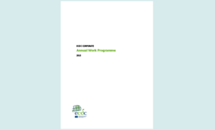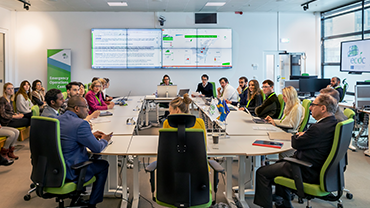Annual Work Programme 2015
The Annual Work Programme for 2015 has been developed based on the Strategic Multi-annual Programme (SMAP) 2014–2020. In relation to this, ECDC will further reinforce the: collaboration and cooperation with EU institutions, Member States and international partners; consolidate its core and support functions; strengthen the role and outputs of the seven disease programmes; and ensure that leadership, administration and ICT efficiently support the core operations of the Centre. The Work Programme has also been prepared with a clear focus on ECDC values, developed in 2010: “service orientation”, “quality based” and “one ECDC”.
Executive Summary
2015 was a special year for ECDC, with a full agenda of business. The Centre will celebrate its 10th anniversary. It will reflect upon the results of its second external evaluations. It will then take appropriate action to address the recommendations its Management Board makes on the basis of this evaluation. But above all else, we will continue to support cooperation between the Commission and Member States against serious cross-border health threats.
In 2014 we have seen an unprecedented epidemic of Ebola in West Africa. The Commission has made good use of the new legal framework established by Decision 1082/2013/EU to coordinate the EU level response to this threat. ECDC, in turn, has fully supported the Commission and the EU Health Security Committee by providing technical support as needed.We have put in place a common reporting system from Ebola cases imported into the EU, produced weekly epidemiological updates on the situation in West Africa, kept our risk assessment under constant review and produced guidance on topics ranging from infection control to how to assess and plan for medical evacuation of patients to the EU by air. We have also worked closely with the Commission and Member States to ensure the EU is well prepared in case the number of imported cases of Ebola here increases.
Our work in 2014 on Ebola is not something ECDC could have planned for in 2013. There is, of course, a certain amount of surge capacity already built in to ECDC’s “business as usual” operations, particularly in our Epidemic Intelligence and Response Support Section. We plan on the basis that there will be a number of outbreaks of EU-level concern each year, even if we cannot predict in advance exactly when or where they will happen – or, indeed, which pathogens will cause them. An event like the West African Ebola epidemic, however, requires more resources than are available from this built in surge capacity. Fortunatley ECDC has a mechanism for this: our Public Health Event (PHE) plan. Activating this plan enables me, as Director, to take some of our experts off their normal duties and assign them full time to working on a PHE, such as Ebola. I can then agree with ECDC’s Management Board to postpone or cancel some activities from the work programme to take account of this reallocation of our experts’ time. ECDC has spent several months of 2014 at level one of its PHE plan. Board members may recall that ECDC made use of this mechanism in 2011 to devote resources to the E.coli outbreak centred on northern Germany and in 2009-2010 during the influenza A(H1N1) pandemic.
In 2015, we can predict that Ebola will continue to be a disease of concern for the EU, and so for ECDC. This is taken account of in the activities planned by our Emerging and Vector-borne Disease Programme (EVD), where viral haemorragic fevers become a priority topic. This family of pathogens includes the Lassa and Marburg viruses as well as Ebola. However, the technical and public health issues for these viruses are the same to a large degree so it makes sense to look at them collectively. It is also worth noting that Europe has seen imported cases of both Lassa fever and Marburg in the past, so it is sensible to strengthen our preparedness against these at the same time as Ebola. What it is not possible to predict in 2015 is the exact course that the Ebola epidemic will take and the demands that this might place on ECDC. Nor is it possible to predict whether there will be other major outbreaks or epidemics of EU-level significance that go beyond our built in surge capacity. This inherent unpredictability of infectious diseases is why we have the mechanism – via our PHE plan – to rapidly reallocate resources when needed.
Another priority activity that is difficult to plan for is implementing recommendations that come out of the external evaluation of ECDC. The final report of this evaluation has been delivered in October and its findings will be presented during MB32 in November. The MB’s Recommendations Drafting Group will develop recommendations based on this report. It will then be for the full Board at its meeting MB33 in March to discuss and agree upon its recommendations. Implementing these recommendations will the be a priority for the ECDC Director, and I would fuly expect to start work on this during 2015. But I do not wish to pre-empt the Board’s discussions by planning on the basis of what I think the recommendations might be. We will make the necessary arrangements once the Board has delivered its opinion.
As I have stressed in this foreword, ECDC is a flexible, adaptable and responsive organisation. It is inherent in the type of work we do, it is designed into our matrix structure and it is part of our organisational culture. We have a team of decicated professionals who are always willing to show flexibility, or put in extra hours, to protect public health. But there are limits to what we can expect of them. Over the last few months of 2014 our experts have been under a large amount of pressure. What is more, I do not see the situation getting much better over the next few years. Success tends to breed success: I would anticipate the Commission and HSC continuing to be very active on future outbreaks and epidemics, and continuing to call on ECDC for support. At the same time ECDC has to continue cutting four posts every year between now and 2018.
2015 will be an opportunity to reflect on and celebrate what ECDC has a achieved in ten short years. We will conduct a bundle of activities to highlight what has been achieved jointly with colleagues in the Member States, the Commission and other stakeholders. The results of the external evaluation give us an opportunity to see how we can achieve even more in the next ten years of ECDC. But as we define our ambitions for the future, ECDC’s Board and ECDC’s partners need to ask themselves whether those ambitions are in line with the Centre’s resources.
Download








